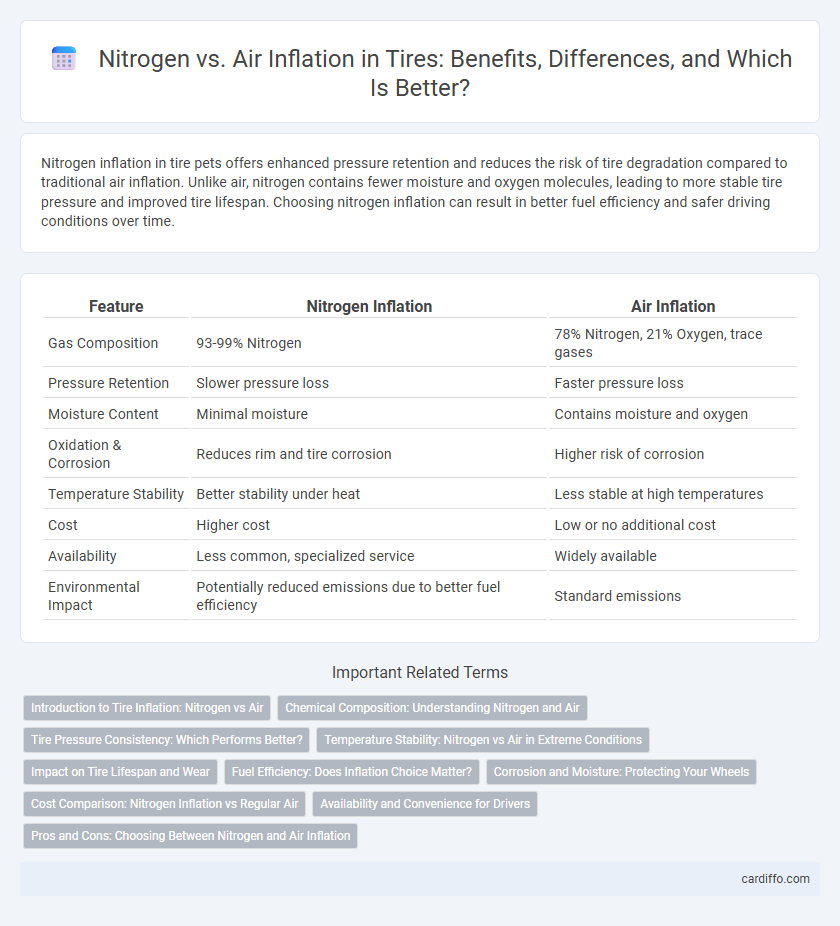Nitrogen inflation in tire pets offers enhanced pressure retention and reduces the risk of tire degradation compared to traditional air inflation. Unlike air, nitrogen contains fewer moisture and oxygen molecules, leading to more stable tire pressure and improved tire lifespan. Choosing nitrogen inflation can result in better fuel efficiency and safer driving conditions over time.
Table of Comparison
| Feature | Nitrogen Inflation | Air Inflation |
|---|---|---|
| Gas Composition | 93-99% Nitrogen | 78% Nitrogen, 21% Oxygen, trace gases |
| Pressure Retention | Slower pressure loss | Faster pressure loss |
| Moisture Content | Minimal moisture | Contains moisture and oxygen |
| Oxidation & Corrosion | Reduces rim and tire corrosion | Higher risk of corrosion |
| Temperature Stability | Better stability under heat | Less stable at high temperatures |
| Cost | Higher cost | Low or no additional cost |
| Availability | Less common, specialized service | Widely available |
| Environmental Impact | Potentially reduced emissions due to better fuel efficiency | Standard emissions |
Introduction to Tire Inflation: Nitrogen vs Air
Tire inflation with nitrogen offers more stable pressure levels compared to regular air, reducing the frequency of pressure checks and improving fuel efficiency. Nitrogen molecules are larger and less permeable, resulting in slower leakage and better maintenance of optimal tire pressure. Regular air contains moisture and oxygen, which can cause oxidation and pressure fluctuations, potentially impacting tire lifespan and performance.
Chemical Composition: Understanding Nitrogen and Air
Nitrogen inflation uses gas that is approximately 93-95% nitrogen, minimizing the presence of oxygen, moisture, and other impurities found in regular air, which is composed of about 78% nitrogen, 21% oxygen, and trace gases. The reduced oxygen content in nitrogen inflation significantly lowers oxidation and corrosion within the tire, enhancing tire durability and maintaining consistent pressure. Air inflation introduces moisture and oxygen that can cause rubber degradation and pressure fluctuations due to temperature changes, affecting overall tire performance.
Tire Pressure Consistency: Which Performs Better?
Nitrogen inflation maintains tire pressure more consistently than regular air due to its larger molecular size, which reduces permeation through the tire walls. This results in slower pressure loss, leading to improved fuel efficiency and extended tire life. Studies indicate nitrogen-filled tires can retain optimal pressure up to four times longer compared to air-inflated tires.
Temperature Stability: Nitrogen vs Air in Extreme Conditions
Nitrogen inflation maintains more consistent tire pressure and temperature stability in extreme conditions due to its lower thermal expansion rate compared to air. This results in less pressure fluctuation, improving tire longevity and performance during rapid temperature changes. Air inflation contains moisture and oxygen, which can cause greater pressure variability and increased heat build-up, potentially leading to faster tire degradation.
Impact on Tire Lifespan and Wear
Nitrogen inflation reduces oxygen and moisture inside tires, minimizing oxidation and corrosion, which significantly extends tire lifespan and maintains tread integrity. Air inflation contains approximately 21% oxygen and water vapor, accelerating rubber degradation and causing uneven wear due to faster pressure loss. Studies show nitrogen-filled tires retain optimal pressure longer, resulting in improved fuel efficiency and more uniform tire wear patterns.
Fuel Efficiency: Does Inflation Choice Matter?
Nitrogen inflation maintains more stable tire pressure compared to regular air, reducing rolling resistance and improving fuel efficiency by up to 3% according to some studies. Unlike oxygen-rich air, nitrogen is less prone to pressure fluctuations caused by temperature changes, ensuring consistent tire performance. Consistent tire pressure helps optimize fuel consumption, making nitrogen inflation a viable option for drivers seeking better mileage.
Corrosion and Moisture: Protecting Your Wheels
Nitrogen inflation significantly reduces moisture buildup inside tires, which minimizes corrosion on wheel rims compared to regular air inflation that contains up to 5% moisture. The absence of water vapor in nitrogen-filled tires prevents oxidation, extending the life of metal components and preserving wheel integrity. Using nitrogen inflation protects wheels from rust and corrosion, enhancing both safety and durability.
Cost Comparison: Nitrogen Inflation vs Regular Air
Nitrogen inflation initially costs more than regular air, with fill-up prices typically ranging from $5 to $10 per tire compared to free or minimal charges for air inflation at most service stations. Over time, nitrogen inflation can lead to cost savings by maintaining more stable tire pressure, reducing wear, and improving fuel efficiency, potentially extending tire lifespan and lowering replacement frequency. Regular air contains moisture and oxygen, which can cause corrosion and faster tire degradation, increasing long-term maintenance expenses.
Availability and Convenience for Drivers
Nitrogen inflation is less widely available than air inflation, making it less convenient for most drivers to find refilling stations, especially during long trips or in remote areas. Air inflation is accessible at nearly all service stations and tire shops, providing greater flexibility for quick tire pressure adjustments. The widespread availability of air inflation ensures drivers can maintain proper tire pressure with ease and minimal disruption.
Pros and Cons: Choosing Between Nitrogen and Air Inflation
Nitrogen inflation in tires offers benefits such as reduced pressure loss, improved fuel efficiency, and enhanced tire life due to its inert properties and lower moisture content compared to regular air. However, nitrogen inflation can be more expensive and less accessible than standard air, which is readily available and sufficient for most everyday driving needs. Air inflation is more convenient and cost-effective, but its moisture and oxygen content can lead to faster tire pressure fluctuations and corrosion inside the tire.
Nitrogen Inflation vs Air Inflation Infographic

 cardiffo.com
cardiffo.com